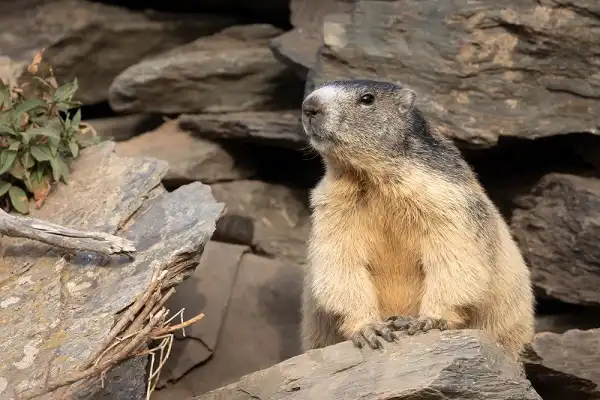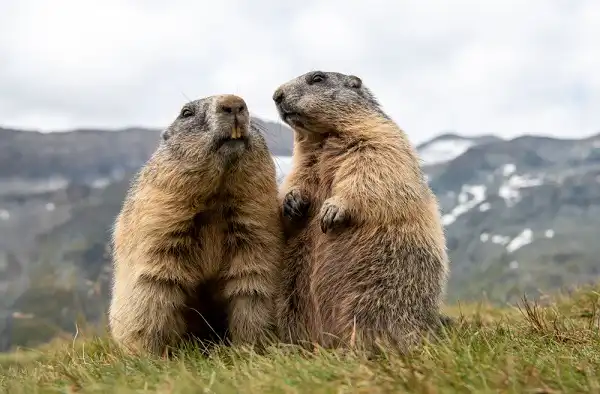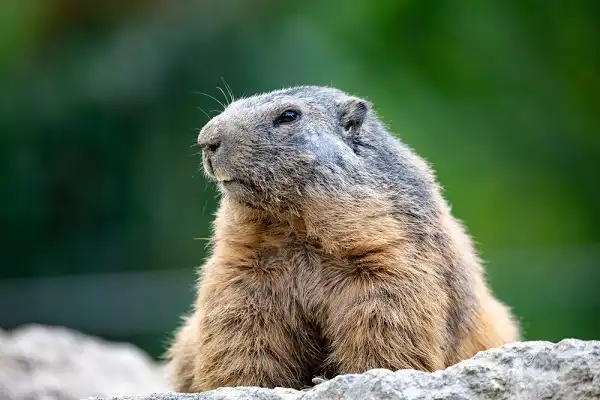Living in the high-lying alpine regions of Europe, North America, and Asia, the Marmot is an iconic member of the squirrel family. From their vibrant fur to a seemingly never-ending voracious appetite for plants, this species can quickly captivate anyone it meets. In this blog post, we will be exploring what makes these incredible animals so unique from other members of the animal kingdom and why they are important to mountain ecosystems all over the world. So join us as we dive into learning about one of nature’s amazing wonders – The Marmot!

Marmot Description
The Marmot is a large rodent known for inhabiting the mountainous regions of Europe, North America, and Asia. Marmots have stout, sturdy bodies with short legs, making them well-suited for their high-altitude habitats. Their thick fur provides insulation against the cold temperatures of the mountain environment, with some species sporting a yellowish or reddish-brown coat that blends in with their rocky surroundings. Their long, sharp claws and powerful limbs allow them to dig complex burrow systems, which can range from a few meters to over 15 meters long.
Marmot Habitat
Marmots are known to inhabit high-altitude regions across three continents, including the alpine regions of Europe, North America, and Asia. They thrive in environments that consist of rocky slopes, grassy meadows, and alpine tundra. Their preferred habitats range from elevations of 5,000 to 13,000 feet, with some species able to tolerate heights of up to 18,000 feet. Marmots typically seek out areas that experience long periods of snow cover, where they can hibernate for the majority of the year. Their burrow systems provide essential shelter during the cold winter months, and the mounds of soil they create have been shown to increase soil aeration and water retention. The location of a Marmot’s burrow is of utmost importance, as they are vulnerable to predators, such as foxes, bears, and eagles. However, their loud vocalizations can alert other colony members of danger, allowing them to take cover underground. Marmots are crucial components of the mountain ecosystem, serving as both pollinators and seed dispersers. They play a vital role in maintaining plant diversity and promoting growth in their habitat. Additionally, they are an important prey item for a variety of predators, including wolves, coyotes, and lynxes.
Marmot Diet
Marmots are primarily herbivorous, with their diet consisting mainly of grasses, leaves, and flowers. However, they have been known to occasionally supplement their diet with insects and other small animals. Being high-altitude animals, Marmots need to consume a large quantity of vegetation to maintain their energy levels and survive the harsh mountain environment. During the summer months, Marmots actively forage for food, gathering as much vegetation as possible to store in their burrow systems for the winter months. They will also consume a large amount of vegetation in the fall to put on fat reserves for the long hibernation period. Marmots have a specialized digestive system that allows them to break down tough vegetation and extract nutrients efficiently. They are able to ferment the cellulose in their food, which produces beneficial acids that help digest their food. This allows them to extract as many nutrients from their food as possible, helping them survive and thrive in their mountain habitats.

Marmot Size
Marmots are a fascinating and unique species that are known for their impressive size. They are typically larger than other rodent species, with the largest species being the Himalayan Marmot, which can grow up to 84 cm in length and weigh up to 8 kg. In contrast, the smallest species, the Yellow-Bellied Marmot, typically grows to a length of about 50 cm and weighs around 4 kg. Marmots display sexual dimorphism, with males being larger and heavier than females. Their size and weight vary depending on the species and the location of their habitat, with those living in higher altitudes tending to be larger than their lowland counterparts. It is important to note that the size and weight of Marmots play a crucial role in their survival and ability to maintain their burrow systems. Their burrow systems must be large enough to accommodate their size and provide shelter from the harsh mountain environment. In addition, their size and weight affect their ability to forage for food and maintain energy levels during the long winter hibernation period.
Marmot Lifespan
Marmots have a relatively long lifespan compared to many other small mammals, with most species living up to around 10-15 years in the wild. However, their lifespan can be significantly longer in captivity, with some individuals living up to 20 years or more. The lifespan of Marmots varies depending on a variety of factors, including their species, habitat, and genetics. Some captive populations have been shown to have longer lifespans than wild populations, which may be due to lower levels of predation and disease as well as better nutrition and veterinary care. Despite these challenges, Marmots have a range of adaptations that help them to survive and thrive in their mountain habitats. Their ability to hibernate for long periods of time allows them to conserve energy during times of low food availability, while their specialized digestive systems help them to extract as many nutrients as possible from their food.
Marmot Behavior
Marmots are known for their fascinating behavior, which is influenced by their social structure and their mountain environment. These animals are primarily active during the day, spending their time foraging for food, maintaining their burrow systems, and engaging in social behaviors with other members of their group. One of the most interesting aspects of marmot behavior is their vocalizations. These animals have a range of sounds that they use to communicate with each other. Some of these sounds are used to warn other members of their group about potential dangers, while others are used to signal aggression or dominance.
Marmots also use vocalizations to establish and maintain their social hierarchies, with dominant individuals often using their calls to assert their dominance over others. Marmots are also known for their complex social structures. These animals live in family groups, which are typically composed of a breeding pair of adults and their offspring. Marmots are highly social animals, and family groups often work together to maintain their burrow systems, forage for food, and protect each other from predators. Within these family groups, there is a clear social hierarchy, with dominant individuals often taking on the majority of the breeding and territorial responsibilities.

Marmot Speed
Marmots are not known for their speed, as they are primarily adapted to life in their burrows and in their mountain habitats. They are generally sluggish animals that move slowly and carefully, conserving their energy for periods when they must forage for food or flee from predators. However, Marmots are capable of sprinting quickly over short distances, reaching speeds of up to 20 miles per hour. This burst of speed is primarily used as a defensive mechanism in response to predators. Interestingly, Marmots have also been observed engaging in play behavior that involves running, jumping, and chasing each other around. While this behavior may not serve a practical purpose, it is thought to contribute to their overall well-being and social bonding. Overall, while speed may not be a defining characteristic of Marmot behavior or survival strategy, they are still capable of impressive bursts of speed when needed and engaging in playful activities that involve running and jumping. As with all aspects of Marmot ecology and behavior, understanding the nuances of their speed and movement patterns will be important for their conservation and ongoing survival in the wild.
Marmot Hunting
Marmots are not typically known for their hunting skills, as they are primarily herbivores that rely on foraging for vegetation to meet their dietary needs. However, they are not entirely defenseless and have been known to employ various tactics to evade predators. In the event that a marmot is cornered by a predator such as a coyote, eagle, or fox, it will use their powerful hind legs to prop itself up and emit a loud alarm call that serves as a warning to other members of their group. Additionally, marmots are known for their impressive burrowing abilities and will quickly retreat to their underground dens if they sense danger. While marmots typically do not engage in aggressive hunting behavior, there have been documented cases of marmots consuming insects and small reptiles. It is believed that these behaviors are primarily a result of nutritional deficiencies and occur infrequently in marmot populations.
Marmot Types
There are 15 species of marmots, including the Alpine Marmot, Hoary Marmot, Yellow-Bellied Marmot, and Gray Marmot. Each species is adapted to its particular environment and has a unique set of behaviors that helps it survive in its environment. The most common marmots are found in North America and Europe. Additionally, isolated populations of some species can be found in Japan, China, Central Asia, and parts of India. However, some species have become very rare due to hunting and loss of habitat.

Marmot Reproduction
Marmots typically reproduce once per year, with the mating season taking place in late summer. During this time, adult males will compete for access to females by chasing them around and displaying their dominance. Females typically give birth to litters of 2 to 10 offspring after a gestation period of roughly one month. The newborns are helpless at first, but they quickly develop their characteristic behaviors and gain independence within two weeks. As they grow older, marmots will disperse from their family group when they reach sexual maturity and stay on the move until they find a suitable habitat in which to set up their own burrow systems.
Conclusion
Marmots are fascinating creatures that occupy a unique ecological niche in mountain habitats around the world. From their burrowing abilities to their social behavior, vocalizations, and physical adaptations, marmots demonstrate an impressive range of behaviors. As we work to conserve these animals and their mountain homes, understanding the nuances of their behavior will be critical for our success. By knowing more about how they live and interact with their environment, we can ensure that future generations can continue to appreciate the beauty and majesty of these incredible creatures.
Frequently Asked Question


